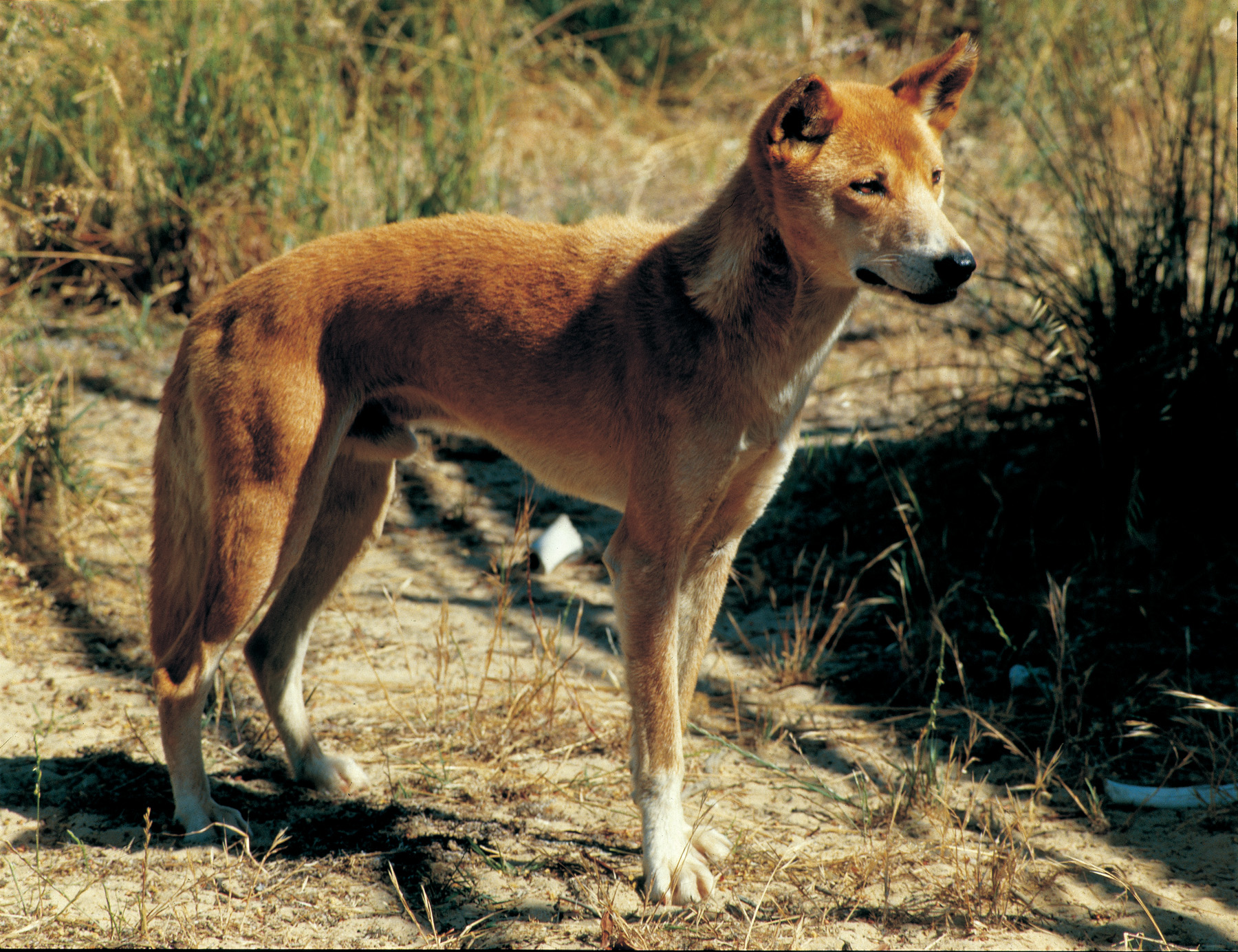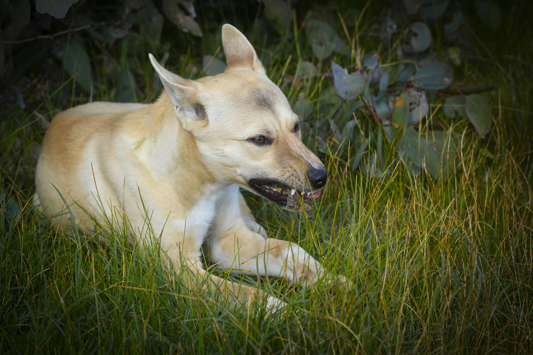
Origin and description
Wild dogs are free roaming dogs. The term refers to purebred dingoes, dingo hybrids, and domestic dogs that have escaped or been deliberately released and now live in the wild. Both dingoes and wild domestic dogs are the same species, Canis familiaris.
The dingo is a primitive dog that evolved from the Indian or Pallid wolf. It is believed dingoes were introduced into Australia about 4500 years ago by Asian seafarers, rather than during an Aboriginal migration.
Dingoes are anatomically like domestic dogs. They can be any colour but are usually sandy-red or ginger coloured or black and tan, with white feet, and a white tail tip.
Escaped domestic dogs have interbred with dingoes, and most wild dog populations include a level of hybridisation. The extent of hybridisation across Australia broadly reflects the intensity of human settlement. In Western Australia, dingo purity is higher than 59%. Within populations of wild dogs, there is a low proportion of purely domestic dogs.
Stock losses from wild dogs in the rangelands of WA alone are estimated at $25 million per annum.
Problems caused by wild dogs
Wild dog predation on livestock takes a heavy economic and emotional toll on livestock producers in affected pastoral and agricultural areas. In addition to significant annual stock losses to wild dogs, their threat is a major deterrent to restocking livestock enterprises, and associated services, such as transport and shearing.
Small livestock are extremely vulnerable to the impacts of wild dogs. When wild dogs move into sheep paddocks, they harass, bite and kill sheep, often without eating them. This behaviour may be a response to the presence of an abundant and panicky prey in flight. Predation of sheep can be recognised by the type of damage caused.
Cattle can withstand wild dog attacks to a greater extent. However, groups or packs of wild dogs may attack and kill young cattle. Considerable variation in losses of calves have been recorded, ranging from negligible to significant in some areas.
Wild dog biology, behaviour, and ecology | PestSmartMore information
Wild dogs occur in locations with suitable supplies of food and water. The diet of wild dogs is flexible; they tend to eat whatever food is available. In many parts of WA, kangaroos and emus feature prominently in the diet. Stomach analysis has also revealed insects, carrion, rabbits, and some relatively rare native species.
Wild dogs are highly social animals. They live in well-defined home ranges in groups of 2 to 10 or more, but members of the group are seldom seen together. Most of the time they form small, flexible sub-groups.
They sometimes hunt individually but may cooperate when chasing larger and more mobile prey, such as kangaroos. Large packs or groups are seldom seen in areas with wild dog control activities or insufficient food supply.
Individual wild dogs sometimes leave their home range, probably due to social pressures. They will travel until they find suitable unclaimed territory in which to settle.
Wild dogs are absent from most close-settled farming areas of the state’s south west, but may still be found in some forested areas.
Dingo and hybrid wild dogs differ from domestic dogs in their breeding cycle. Females have only one well defined breeding season each year. They come on heat between March and May, and whelp between June and August. Litters are rarely born at other times. Sperm production in the male is also subject to seasonal fluctuations, with few viable sperm produced in summer.
There is a high mortality rate among young wild dogs but those that survive may live to 6 or 7 years. In undisturbed social groups, usually only the dominant females' pups are raised each year, which tends to limit numbers.
When group hierarchies are disrupted, for example, by control measures, more females may raise litters, leading to increased numbers of juveniles.
Wild dogs are declared pests for the whole of Western Australia under section 22 of the Biosecurity and Agriculture Management Act 2007.
The Western Australian Organism List (WAOL) describes the control and keeping categories and areas in which this pest is declared for each of the following groups: dingoes, dingo hybrids, and feral dogs (Canis familiaris).
Western Australia’s wild dog management policy is to control all wild dogs, including dingoes, in and near livestock grazing areas. In other areas, dingoes are left undisturbed.
Dingoes — native wildlife
Dingoes are considered native wildlife under the Biodiversity Conservation Act 2016 (BC Act). An exemption order under section 271 of the BC Act means that no licenses are required to keep dingoes or control or take them as a biosecurity requirement. Wild dog management activities must comply with the Animal Welfare Act 2002 (AW Act), which requires that pest animals are handled and killed humanely, and the cruelty provisions of the AW Act.
The management of wild dogs in WA is guided by the Western Australian Wild Dog Action Plan 2016-2021, which aims to facilitate a coordinated and well-resourced approach to wild dog control.
The wild dog action plan is part of WA’s long-term commitment to wild dog control. This includes:
- management of the State Barrier Fence. Through a previous $10.6 million investment funding, new fencing was installed to fill a 170 km gap, and the fence was upgraded to wild dog standard.
- funding for the State Barrier Fence Esperance extension (in progress)
- wild dog control support for industry and landholders through biosecurity groups. Recognised Biosecurity Groups (RBGs) have the option to collect Declared Pest Rates to fund declared pest control, including for wild dogs. These rates are matched by WA government. The department administers the declared pest account in which these funds are received, held, and allocated.
- ensuring the safe use of restricted chemical products (such as 1080 and strychnine) for their ongoing use by industry for the control of pests, including wild dogs.
-
Western Australian wild dog action plan 2016 - 2021
Under the Biosecurity and Agriculture Management Act 2007, landholders (that is, landowners and occupiers) are responsible for wild dog control on their land and must ensure they use the most humane method available. Refer to the page, Bait and poison directory for vertebrate pests in Western Australia for more information.
Available control options include:
- ground and aerial baiting with meat poisoned with 1080 (sodium fluoroacetate)
- canid pest ejectors
- trapping using strychnine
- fencing
- trapping and shooting
- non lethal deterrents

